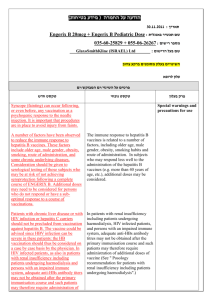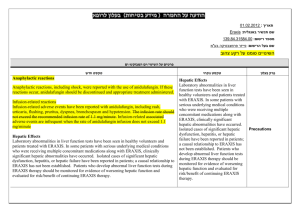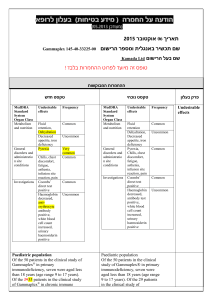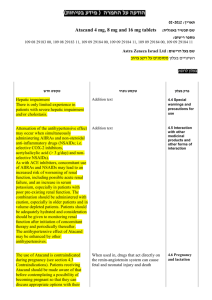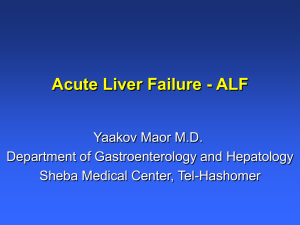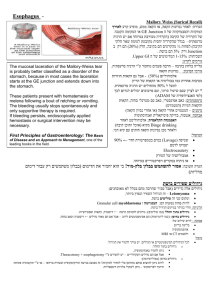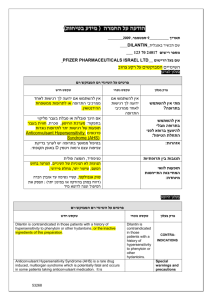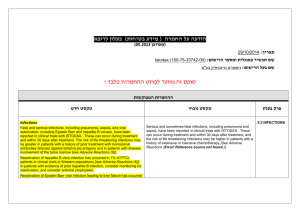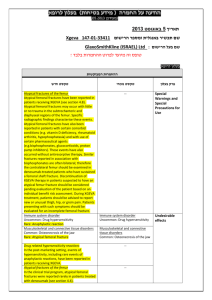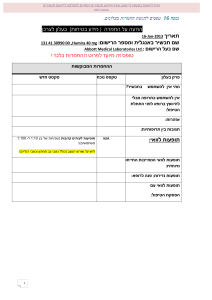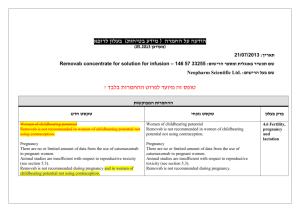הודעה על החמרה ( מידע בטיחות) בעלון לצרכן
advertisement
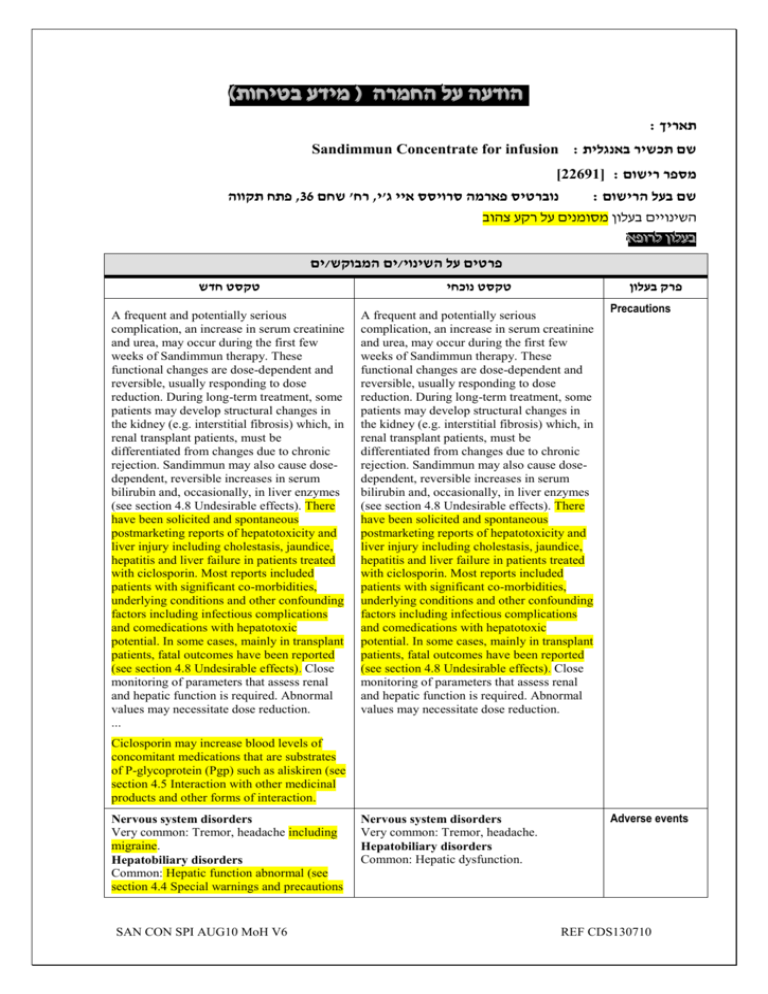
)בטיחות )מידע בטיחות החמרה (( מידע על החמרה הודעה על הודעה : תאריך Sandimmun Concentrate for infusion : שם תכשיר באנגלית [22691] : מספר רישום פתח תקווה,63 רח' שחם,נוברטיס פארמה סרויסס איי ג'י : שם בעל הרישום השינויים בעלון מסומנים על רקע צהוב רופא בעלון ללרופא בעלון ים/ים המבוקש/פרטים על השינוי טקסט חדש טקסט נוכחי פרק בעלון A frequent and potentially serious complication, an increase in serum creatinine and urea, may occur during the first few weeks of Sandimmun therapy. These functional changes are dose-dependent and reversible, usually responding to dose reduction. During long-term treatment, some patients may develop structural changes in the kidney (e.g. interstitial fibrosis) which, in renal transplant patients, must be differentiated from changes due to chronic rejection. Sandimmun may also cause dosedependent, reversible increases in serum bilirubin and, occasionally, in liver enzymes (see section 4.8 Undesirable effects). There have been solicited and spontaneous postmarketing reports of hepatotoxicity and liver injury including cholestasis, jaundice, hepatitis and liver failure in patients treated with ciclosporin. Most reports included patients with significant co-morbidities, underlying conditions and other confounding factors including infectious complications and comedications with hepatotoxic potential. In some cases, mainly in transplant patients, fatal outcomes have been reported (see section 4.8 Undesirable effects). Close monitoring of parameters that assess renal and hepatic function is required. Abnormal values may necessitate dose reduction. ... A frequent and potentially serious complication, an increase in serum creatinine and urea, may occur during the first few weeks of Sandimmun therapy. These functional changes are dose-dependent and reversible, usually responding to dose reduction. During long-term treatment, some patients may develop structural changes in the kidney (e.g. interstitial fibrosis) which, in renal transplant patients, must be differentiated from changes due to chronic rejection. Sandimmun may also cause dosedependent, reversible increases in serum bilirubin and, occasionally, in liver enzymes (see section 4.8 Undesirable effects). There have been solicited and spontaneous postmarketing reports of hepatotoxicity and liver injury including cholestasis, jaundice, hepatitis and liver failure in patients treated with ciclosporin. Most reports included patients with significant co-morbidities, underlying conditions and other confounding factors including infectious complications and comedications with hepatotoxic potential. In some cases, mainly in transplant patients, fatal outcomes have been reported (see section 4.8 Undesirable effects). Close monitoring of parameters that assess renal and hepatic function is required. Abnormal values may necessitate dose reduction. Precautions Ciclosporin may increase blood levels of concomitant medications that are substrates of P-glycoprotein (Pgp) such as aliskiren (see section 4.5 Interaction with other medicinal products and other forms of interaction. Nervous system disorders Very common: Tremor, headache including migraine. Hepatobiliary disorders Common: Hepatic function abnormal (see section 4.4 Special warnings and precautions SAN CON SPI AUG10 MoH V6 Nervous system disorders Very common: Tremor, headache. Hepatobiliary disorders Common: Hepatic dysfunction. Adverse events REF CDS130710 ים/ים המבוקש/פרטים על השינוי טקסט חדש טקסט נוכחי פרק בעלון for use). ... Other adverse drug reactions from post-marketing experience There have been solicited and spontaneous postmarketing reports of hepatotoxicity and liver injury including cholestasis, jaundice, hepatitis and liver failure in patients treated with ciclosporin. Most reports included patients with significant co-morbidities, underlying conditions and other confounding factors including infectious complications and comedications with hepatotoxic potential. In some cases, mainly in transplant patients, fatal outcomes have been reported (see section 4.4 Special warnings and precautions for use). Ciclosporin is a highly potent Pgp inhibitor and may increase blood levels of concomitant medications that are substrates of Pgp such as aliskiren. Following concomitant administration of ciclosporin and aliskiren, the Cmax of aliskiren was increased by approximately 2.5 fold and the AUC by approximately 5 fold. However, the pharmacokinetic profile of ciclosporin was not significantly altered. Caution is recommended when co-administering ciclosporin together with aliskiren (see section 4.4 Special warnings and precautions for use). SAN CON SPI AUG10 MoH V6 Drug Interactions REF CDS130710
